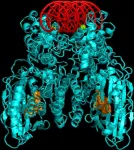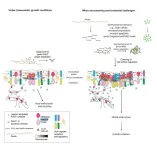(Press-News.org) Women may find it harder to emotionally adjust to divorce or a relationship break-up in later life than men do, if patterns of antidepressant use are indicative, suggests a large long term study published online in the Journal of Epidemiology & Community Health.
While both sexes increased their antidepressant use in the run up to, and immediate aftermath of, a divorce, break-up, or bereavement, women’s use of these drugs was greater than men’s. And while re-partnering was associated with a slight reduction in antidepressant use in both sexes, it was particularly short-lived in women, the study findings indicate.
Due to population ageing, ‘grey divorce’ from the age of 50 onwards is on the rise in high-income countries, and consequently, so is re-partnering, note the researchers.
Later life depression is also relatively common, with an estimated 10–15% of over-55s experiencing clinically significant depressive symptoms, they add. But few studies have looked at the psychological impact of later life divorce/relationship break-ups, or bereavement, or a new relationship on antidepressant use.
The researchers therefore decided to track the patterns of antidepressant use between 1996 and 2018 among 228,644 older Fins, aged 50 to 70, who had gone through divorce, relationship break-up, or bereavement, and the impact of subsequent re-partnering in those who had done so.
In all, 85,031 (37%) were bereaved; 75,009 (33%) were divorced; and 68,604 (30%) stopped living with a partner as a result of a break-up. Subsequently 53,460 people entered into a new relationship within 2 to 3 years, on average: 31,238 after a break-up; 15,958 after a divorce; and 6,264 after the death of their partner.
More men than women re-partnered after bereavement or a relationship break-up. There were no obvious sex differences in re-partnering after a divorce.
Both men and women whose partners died, increased their use of antidepressants between 4 and 1 year(s) before the event, with a steep increase in the 3 months before and the 3 months afterwards: by just under 5.5% in men; by nearly 7% in women. Use fell back subsequently but still remained higher than before.
Similarly, antidepressant use increased in the 6 months before divorce for both sexes: by 5% in men; by 7% in women. Immediately afterwards it fell back for both men and women, stabilising after 1 year. But it remained higher than before the divorce.
Women experiencing a break-up significantly increased their use of antidepressants in the 4 years preceding the event. Men also upped their use of these drugs, but to a much lesser extent: by just over 3% compared with 6% among the women.
Within a year, antidepressant use fell back to the level it was 12 months before the break-up and subsequently remained at that level among the men. But it was a different story for women as their use tailed off only slightly immediately afterwards, and was short-lived, increasing again from the first year onwards.
“The partial recovery and the continuous increase in [antidepressant] use appear to support the marital resource model which…suggests that losing the partner may bring stressful changes in life circumstances (eg, decreased household income, loss of social support) that persist or accumulate over time,” explain the researchers.
“The resource model still seems to apply more to women who separated from co-habitation than to their male counterparts.”
Small falls in [antidepressant] use associated with re-partnering were observed, but they were short-lived as use of these drugs returned to the level observed before re-partnering or remained even higher 2 years afterwards, “supporting the honeymoon effect documented in prior research, particularly among bereaved individuals,” note the researchers.
While gender role differences may help explain some of the heavier mental health consequences for women, they usually have better social networks than men to help mitigate some of these effects, suggest the researchers.
“The greater increases in [antidepressant] use associated with union dissolution among women in our study may indeed relate to the fact that the costs of union dissolution on mental health fall more heavily on women than men,” they write.
“The smaller declines in [antidepressant] use associated with re-partnering in women than in men may be related to the explanations that marriage benefits men’s mental health to a greater extent than women’s, and older men are more likely than women to seek emotional support from re-partnering.
“In addition, women may take greater responsibilities to manage interpersonal relationships between the blended families, such as those with the partner’s children, which could undermine their mental health,” they add.
This is an observational study, and as such, can’t establish cause. And the researchers acknowledge various limitations to their findings, including the inability to account for the number and length of partnerships. Family support networks and living arrangements, which weren’t fully examined, may also have had some bearing on the use of these drugs.
But they conclude: “Our findings underscore the challenges of adapting to union dissolution in later life and the associated need for support.”
END
Women may find it harder to adjust to later life divorce and break-ups than men
Their antidepressant use is higher and tails off only slightly and briefly after re-partnering
2024-02-07
ELSE PRESS RELEASES FROM THIS DATE:
High weekly physical activity levels linked to lower kidney disease risk in diabetes + overweight/obesity
2024-02-07
Clocking up high weekly levels of moderate to vigorous intensity physical activity is linked to a lower risk of developing chronic kidney disease in overweight/obese people with type 2 diabetes, finds research published online in the British Journal of Sports Medicine.
But boosting the weekly tally by just over an hour is linked to a 33% reduction in risk, with the effects apparent for bouts lasting above or below 10 minutes at a time, the findings indicate.
Diabetes is the leading cause of chronic kidney disease, accounting for 30–50% of all such cases. Diabetes plus chronic kidney disease is associated with a 10-fold or greater increase in the risk of death from any cause ...
Monterey Bay Aquarium study reveals how kelp forests persisted through the large 2014-2016 Pacific marine heatwave
2024-02-07
New research led by Monterey Bay Aquarium and the University of California, Santa Cruz, reveals that denser, and more sheltered, kelp forests can withstand serious stressors amid warming ocean temperatures. Published in Proceedings of the Royal Society B, the study also offers the first comprehensive assessment of how declines in kelp abundance affected marine algae, invertebrates, and fishes living in Monterey Bay. The study comes after a multi-year marine heatwave – the product of a 2014 ‘blob’ ...
Early drawing and building skills linked to enhanced education and behaviour in children
2024-02-07
Fine motor skills in young children are linked to better GCSE scores and fewer behavioural problems in childhood and adolescence, according to a new study from the University of Surrey and Birkbeck, University of London. The authors suggest that preschool fine motor skills, including drawing, folding paper and block building, may play an important role in the pathway between infancy and later educational and behavioural outcomes in primary and secondary school.
The study showed that fine motor skills ...
NLR researcher named Fellow of Society of Photo-Optical Instrumentation Engineers (SPIE)
2024-02-07
WASHINGTON – U.S. Naval Research Laboratory research physicist Lynda E. Busse, Ph.D., was named a Fellow of SPIE, the international society for optics and photonics, for outstanding technical contributions to the development of novel infrared (IR) optical materials and photonics devices.
Announced December 2023, the 47 new Fellows represent high-profile leaders in academia, industry, and government, and are being honored for their technical achievements as well as for their service to SPIE and the optics and photonics community. Dr. Busse was recognized along with many of the other new Fellows at the 2024 SPIE Photonics West Conference in San Francisco, California ...
A Filipino fruit dove, long part of Peabody collection, reveals its secrets
2024-02-06
In May 1953, Filipino ornithologist D. S. Rabor collected a single female fruit dove on the forested slopes of an active volcano on the Philippine island of Negros. The small apple green bird, which had yellow edgings on its wings and prominent circles of bare skin around its eyes, was unlike any other known pigeon species. In 1954, Rabor and Yale professor Dillon Ripley described the unique specimen as Ptilinopus arcanus, a name inspired by the Latin word for “secret.”
The Negros Fruit Dove, as it is commonly known, has never been ...
New study finds “sweet spot” for length of yarn-shaped supercapacitors
2024-02-06
As interest in wearable technology has surged, research into creating energy-storage devices that can be woven into textiles has also increased. Researchers at North Carolina State University have now identified a “sweet spot” at which the length of a threadlike energy storage technology called a “yarn-shaped supercapacitor” (YSC) yields the highest and most efficient flow of energy per unit length.
“When it comes to the length of the YSC, it’s a tradeoff between power and energy,” said Wei ...
New approach to tackling bacterial infections identified
2024-02-06
New York, NY (February 6, 2024)—Researchers at the Icahn School of Medicine at Mount Sinai have identified a new approach to controlling bacterial infections. The findings were described in the February 6 online issue of Nature Structural & Molecular Biology [DOI # 10.1038/s41594-024-01220-x].
The team found a way to turn on a vital bacterial defense mechanism to fight and manage bacterial infections. The defense system, called cyclic oligonucleotide-based antiphage signaling system (CBASS), is a natural mechanism ...
Study: Using Nutrition Facts labels linked to healthier eating choices among eighth and 11th grade students
2024-02-06
Using the Nutrition Facts labels to make food choices is significantly associated with healthy eating among eighth and 11th grade students in Texas, although the proportion of students using nutrition labels to make their food choices is low, according to research from UTHealth Houston.
A study led by first author Christopher D. Pfledderer, PhD, MPH, assistant professor in the Department of Health Promotion and Behavioral Sciences at UTHealth Houston School of Public Health, and senior author Deanna Hoelscher, PhD, RDN, the John P. McGovern Professor in Health Promotion and regional dean of the ...
Researchers at UMass Amherst discover key to molecular mystery of how plants respond to changing conditions
2024-02-06
AMHERST, Mass. – A team of researchers from the University of Massachusetts Amherst recently published a pioneering study that answers a central question in biology: how do organisms rally a wide range of cellular processes when they encounter a change—either internally or in the external environment—to thrive in good times or survive the bad times? The research, focused on plants and published in Cell, identifies the interactions between four compounds: pectin, receptor proteins FERONIA and LLG1 and the signal RALF peptide. In particular, the team discovered that a molecular condensation process, called liquid-liquid phase separation, that ...
Patients with cancer who suffered a major adverse financial event more likely to be diagnosed with advanced stage disease
2024-02-06
New findings led by researchers at the American Cancer Society (ACS) and the National Cancer Institute (NCI) show more than one-third of cancer patients had a major adverse financial event – bankruptcy, lien, or eviction – before their cancer diagnosis. These patients with adverse financial events (AFEs) had a later-stage diagnosis compared with patients with no events. The findings are published today in the Journal of Clinical Oncology (JCO).
“Patients with a previous AFE not only face greater likelihood of more advanced cancer but also may encounter substantial barriers to receiving recommended care ...
LAST 30 PRESS RELEASES:
CBD treatment reverses key effects of fetal alcohol spectrum disorder in a mouse model
Blood sugar spikes linked to higher risk of Alzheimer's disease
Staying single for longer affects young people’s well-being
New method allows scientists to 3D-print structures within cells
Screening tool helps identify brain-related comorbidities in individuals with Duchenne muscular dystrophy
How do the active ingredients of monkfruit affect health?
News language and social networks: how do they affect the spread of immigration attitudes?
Researchers discover trigger of tendon disease
Your pet's flea treatment could be destroying the planet
Diabetes risk not associated with timing or type of menopause
Bulk inorganic crystals grown from water emit “handed” light
A new AI-based attack framework advances multi-agent reinforcement learning by amplifying vulnerability and bypassing defenses
While exploring the cosmos, astronauts also fuel explorations of the biology of aging and cellular resilience
Design and synthesis of Zr-IR825 nanoparticles for photothermal therapy of tumor cells
Food critics or food grabbers? When choosing food, wood mice split into careful examiners who sniff and handle, and quick nut grabbers
‘Cosmic clock’ reveals Australian landscapes’ history and potential future
Higher maternal blood pressure increases the risk of pregnancy complications, study concludes
Postoperative complications of medical tourism may cost NHS up to £20,000/patient
Phone apps nearly 3 times as good as no/basic support for quitting smoking long term
Female sex and higher education linked to escalating prevalence of obesity and overweight in Africa
THE LANCET + eCLINICALMEDICINE: Two studies on reductions in mortality from small changes lifestyle changes
AI model identifies how every country can improve its cancer outcomes
Young people risk drifting into serious online offenses through a slippery slope of high-risk digital behavior
Implant provides lasting relief for treatment-resistant depression
Autologous T cell therapy targeting multiple antigens shows promise treating pancreatic cancer
First extensive study into marsupial gut microbiomes reveals new microbial species and antimicrobial resistance
Study debunks myth of native Hawaiians causing bird extinctions
Tailored biochar could transform how crops grow, resist disease, and clean polluted soils
Biochar-based enzyme technology offers new path for cleaner water and soil
Biochar helps farmland soils withstand extreme rain and drought by steadying carbon loss
[Press-News.org] Women may find it harder to adjust to later life divorce and break-ups than menTheir antidepressant use is higher and tails off only slightly and briefly after re-partnering





